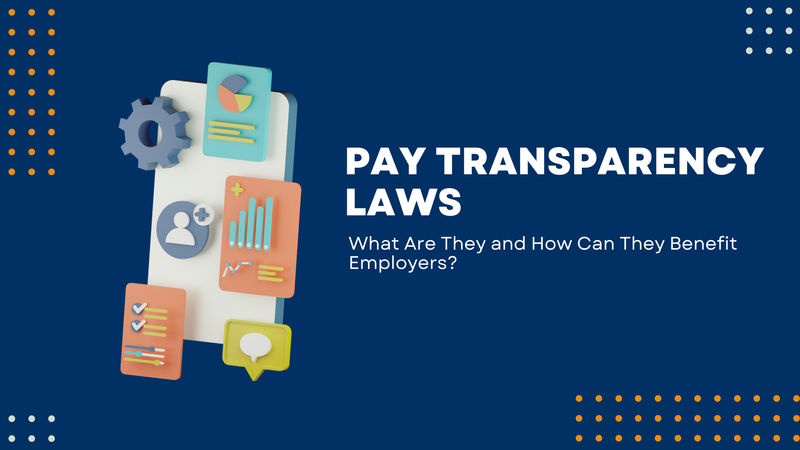
Pay Transparency Laws: What Are They and How Can They Benefit Employers?
Posted on 07/06/23 By Guest Contributor
Asking someone how much they make in their job is considered taboo and a major faux pas in some circles. We have long been told that talking about salaries and how much someone makes crosses a line. However, this view is starting to evolve, and there are many who are now beginning to advocate for a greater amount of pay transparency across all jobs. In fact, 23 states have enacted or are considering pay transparency laws.
What Are Pay Transparency Laws?
Pay transparency laws are regulations that require employers to disclose information about employee compensation, such as salaries, bonuses, and benefits, to their employees or the public. For some states, this can include requiring employers to disclose salary ranges to job applicants in job postings, during the hiring process, or upon request. The specific requirements of pay transparency laws can vary by jurisdiction.
In general, pay transparency laws aim to promote fairness and equity in the workplace by increasing transparency around compensation. They can help ensure that employees are paid fairly for their work and that there is no discrimination in pay based on factors such as gender, race, or age.
Where Are Pay Transparency Laws in Effect?
There are pay transparency laws and requirements in numerous states already, and many other states are also seeking to get on board with enacting pay transparency laws. A few of the places where pay transparency laws exist right now include:
- California
- Colorado
- Connecticut
- Maryland
- Nevada
- Jersey City, NJ
- Ithaca, NY
- New York City
- New York (goes into effect September 2023)
- Westchester County, NY
- Cincinnati, OH
- Toledo, OH
- Rhode Island
- Washington
As you can see, in some cases, specific jurisdictions have decided to take up the mantle of pay transparency laws on their own, even if the state has not. Therefore, employers should keep an eye on the latest pay transparency laws in their area and what they are obligated to do.
The primary obligation enforced by many of these jurisdictions is to release a salary range on any job posting they put out to the public. Therefore, job-seekers have at least some idea of the salary expectations they can reasonably expect to receive and which jobs they are legitimately interested in applying for.
Wording Matters
The wording of a job posting matters significantly. The wage transparency laws in many states and cities now mandate that the employer must make a good-faith effort to post a minimum and maximum salary range for public job postings. For example, in New York City, it is necessary for an employer to avoid wording such as "$15 an hour and up." They have to be concrete about the minimum and maximum salary offered for the position posted.
Washington’s law, amended in 2023, requires employers with 15 or more workers to disclose the salary range or wage scale and a description of all benefits and other compensation in a job posting.
Is Pay Transparency Good for Employers?
Some may see wage transparency as a burden on employers. Complying with the law means spending extra time crafting a job posting in just the right way. However, there are benefits for employers who post jobs with pay transparency.
Lowered Recruiting Costs
SHRM reports studies have found that pay transparency in job postings helps reduce the recruiting costs of any given business. The cost-per-click for ads with pay listed in the title is about 35 percent lower than ads without pay information in the title, according to an analysis conducted by Appcast, a leading job advertising platform. Cost-per-click is calculated by dividing the total number of clicks a posting receives by the cost to promote the listing.
A job posting with a clear salary range can allow candidates to determine upfront if a position meets their financial needs before completing the application process. This can help streamline the recruitment process and save the employer time and money by avoiding candidates that seem to be a good fit but who drop out at the interview stage once the salary is disclosed.
More Qualified Candidates
Pay transparency can be an attractive factor for job seekers. When potential candidates have visibility into the company’s compensation structure, it helps them make informed decisions about whether the organization aligns with their salary expectations and career goals. Additionally, transparent pay practices can aid in retaining talented employees who value fairness and want to work for an organization that promotes transparency.
A Level Playing Field
Finally, implementing pay transparency allows employees to have insight into the pay range for their roles and the roles of their colleagues. Pay transparency helps to ensure employees are paid fairly and is a step in the right direction in decreasing pay gaps.
Promoting an environment of trust and openness can improve the company culture and allow employees the opportunity to advocate for themselves or the employer to demonstrate what the company most values and rewards.
This blog is intended for awareness only, it is not to be used for legal advice or counsel.
Related Articles
Is an HR Certification Worth It? Discussing the Value of Continuing Education [Interview]
Vanessa Collins discusses how earning the PHR certification helped advance her career in human resources.
The evolution of marijuana legality and acceptance in the United States is changing rapidly, leaving human resources professionals concerned about corporate policies that prohibit the use of marijuana in and out of work.
It is essential for company to offer a comprehensive benefits package to employees that will not only attract the best talent from the outset, but retain those talented individuals for years to come.
![Is an HR Certification Worth It? Discussing the Value of Continuing Education [Interview] Is an HR Certification Worth It? Discussing the Value of Continuing Education [Interview]](https://image.lorman.com/article/blog/tr:w-368,h-207/106_is%20an%20HR%20Certification%20Worth%20It%20-%20value%20of%20continuing%20education.png)

